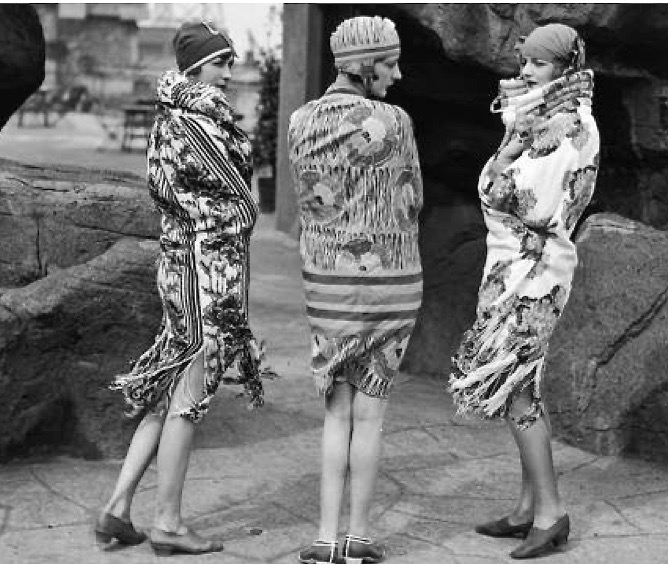
By Stuart Dyer

Palm Beach ladies in their Lilly Pulitzer dresses, 1964
When packing for a vacation to a warm weather destination, have you ever wondered why you are inclined to pack clothing that departs from your everyday look? For example why you are suddenly drawn to vibrantly colorful clothing with bold or wildly patterned prints? Or if traveling in the summer to a location in New England, do you wonder why you happily pack up a sweater with a giant whale on the front and a pair of Nantucket red trousers that you wouldn’t usually wear at home? Why don’t we pack our everyday clothing? Why do we veer away from our usual style to a different one and think nothing of it? When did this idea become ingrained in our psyches? When did resort wear dressing start?
The history of resort wear is very closely tied to the history of the railroad. Recreational travel to escape frigid winters or hot summers became possible only at the end of the nineteenth century, as travel and transportation were revolutionized by the spread of railroads. People had access to locations once too far or too hard to get to by horse and carriage. During this period, many of the legendary Grand Hotels were built by the sea, by lakes, in the mountains and along rivers. According to the book, Resort Fashion, by the end of the 19th century, resorts became destinations and self-contained universes of leisure. Guests enjoyed billiards, bowling, dancing and boating. They were often required to wear different attire for each activity. Ladies sometimes changed their clothing to fit a specific activity up to six times a day! There started to be a need for lighter, freer clothing that allowed the wearer to be somewhat less formal and allowed for freedom of movement.
1920s beach fashions
The period between the two world wars was when luxury travel and resort wear really entered their heyday. Wealthy socialites, actresses and movie stars vacationed in places such as Cannes, Biarritz, St Moritz and Palm Beach. These destinations offered not just the opportunity for relaxation, but also the opportunity to be seen. The public was fascinated by the international elite’s every move and fashion writers flocked to where the elite vacationed in order to photograph and write about what they were doing and what they were wearing. The writers’ stories and images of film stars’ and socialites’ chic outfits were syndicated internationally and helped to popularize the idea of resort wear. Fashion houses set up boutiques at some of the exclusive resorts so that the guests could easily purchase and be seen wearing their clothing. Both Chanel and Madame Vionnet set up boutiques in Biarritz – Chanel in 1915 and Vionnet in 1925.
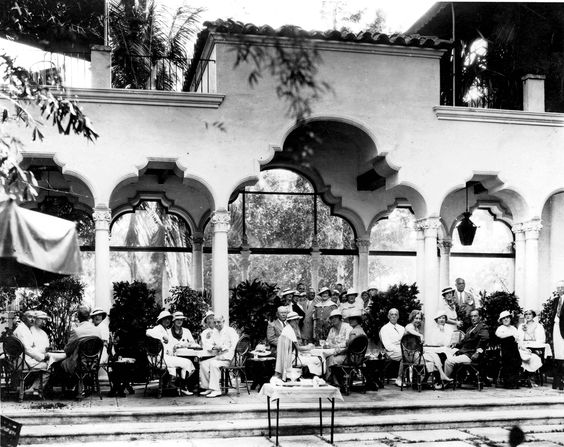
Everglades Club in Palm Beach in the 1920s
This era also ushered in new items of clothing designed specifically to be worn at resorts. One such example are ‘beach pajamas’. They were the height of resort fashion in the 1920s and 1930s and were worn from the afternoon to the evening as a fashionable resort wear staple. Beach pajamas generally consisted of wide legged, loose trousers and a jacket made of matching fabric. At the time, beach pajamas were shocking to some as they were one of the first trousered garments to be worn by western women.
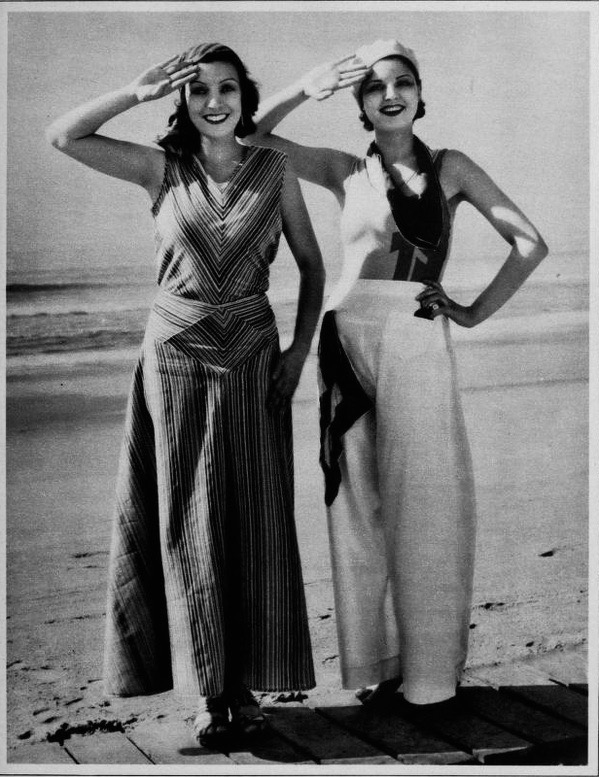
Two ladies in the 1920s wearing beach pajamas
In the economic boom that followed the Second World War, people had more disposable income and more leisure time than ever before. Additionally the price of automobiles and air travel was much less expensive than it had ever been. The middle class were able to enjoy newly accessible travel options thus causing a serge in the popularity of leisure travel. People needed clothing for their travels and retail companies were all too eager to accommodate them. The practice of releasing a line of warm weather clothing in the middle of winter was established and resort wear lines became an annual staple in the fashion industry.
 1950s Playsuit designed by Rose Marie Reid, green and blue striped linen/cotton fabric.
1950s Playsuit designed by Rose Marie Reid, green and blue striped linen/cotton fabric.
The Mid Century period was a time of boom and optimism and the clothing of the time reflected this in its design, color and prints. In the 1950s the ‘playsuit’ emerged as an option for women’s leisure wear. It was incredibly popular. The playsuit was typically constructed as a one piece short and top combination suit. Often it had a matching skirt which could be worn on top. The skirt would be removed once the wearer reached a pool, backyard or beach destination.
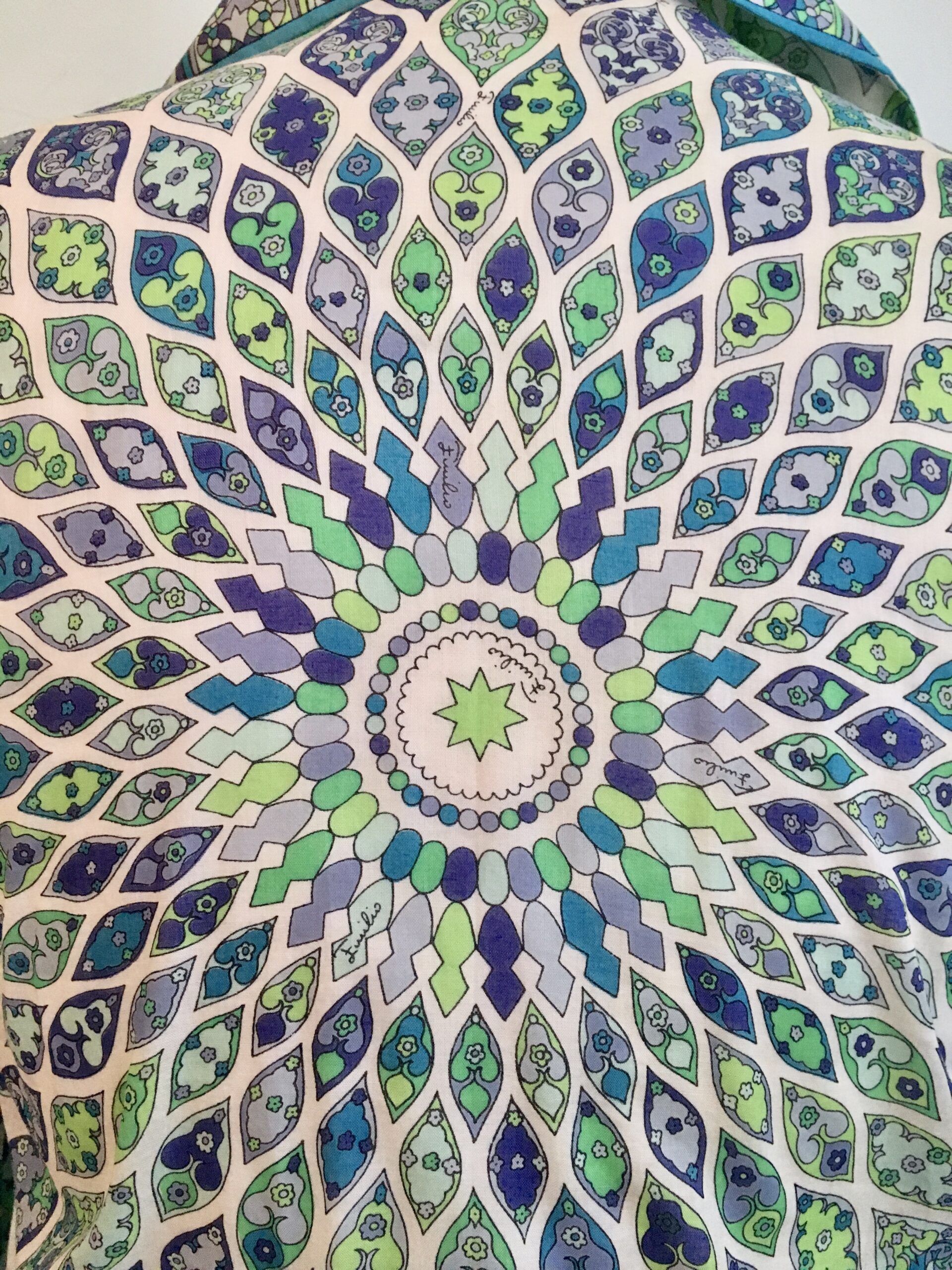 1960s Emilio Pucci print
1960s Emilio Pucci print
Resort wear prints created during the mid century also reflected the optimism of the period. One of the first people credited with creating resort wear prints is Emilio Pucci. In 1949 he opened his first boutique on the island of Capri, Italy. His prints were colorful, kaleidoscopic and abstract. The prints were an instant hit with the Jet Set and became part of their resort wear uniform. Ten years later in the U.S., the American answer to the Pucci print was created by Lilly Pulitzer. While Pucci prints tended to be linear, Lilly prints were whimsical and painterly and had a true sense of fun. Lilly prints were embraced by the American elites and spotted on such ladies as Jacqueline Kennedy.

1960s Lilly Pulitzer cotton shift dress
The 1960s and 1970s brought more of a bohemian vibe to resort wear and introduced more easy going fabrics, peasant blouses and caftans.
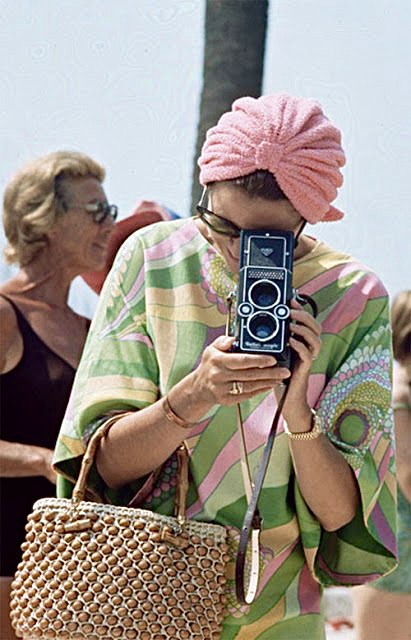
Grace Kelly wearing a caftan and turban in 1972
Leisure travel has become a part of the American Dream and so has resort wear. When one thinks of traveling, thoughts of resort wear are often intertwined. Who hasn’t pictured themselves at a tropical destination sitting poolside enjoying a drink while wearing a flowing caftan? I know I have! Resort wear itself has become a bit of an escapism, capable of transporting our thoughts elsewhere. It has become a part of the American lexicon.
Stuart Dyer is the owner of LadybugVintage.com For more vintage, follow Stuart @ladybugvintage on Instagram



